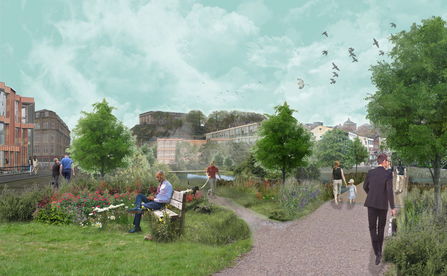I have lived in Nottingham for all 20 years of my life. It is my home and I love it. It is because of this love that I deeply believe that we can and should do more to make our city an even better home for all people and wildlife. With the Broadmarsh reinvention plan proposed by Nottinghamshire Wildlife Trust, converting the derelict site into 100% wildlife-friendly greenspace, we are offered a once in a lifetime chance to transform our city and our lives. This is a chance we cannot afford to miss.

Concept visualisation looking up towards the Castle by Influence
Nottingham is an ambitious city, with the 2028 Carbon Neutral pledge the earliest city-based net zero commitment in the UK. Converting the Broadmarsh into greenspace would increase carbon sequestration, contribute to tree planting targets and mitigate climate change impacts such as heat stress and flooding. Simultaneously with the climate crisis, we are facing an ecological crisis, with scientists warning of an impending Sixth Mass Extinction. Our nature is dying around us, with the State of Nature 2019 report evidencing that 41% of UK species are in decline and 15% are threatened with extinction1 whilst the UK is failing to meet 14 out of 20 UN Biodiversity targets2. Converting the Broadmarsh into space for nature would provide a home for wildlife, a rare biodiversity gain instead of loss, placing Nottingham at the cutting edge of a new way of co-flourishing with nature and signalling its commitment towards the national target of protecting 30% of land for wildlife. Taking such a bold step would truly signal Nottingham’s commitment to tackle the interconnected climate-ecological crises.
Yet this is not some scientific decision solely guided by ecological statistics, it is also about improving our lives. Greenspace is vital to our mental and physical health, with the government’s 2020 Improving Access to Greenspace Report estimating £2.1billion per year would be saved in health costs if everyone had good access to greenspace3. Greenspace is a social justice issue, with people with lower incomes and non-white ethnicities often living in areas with low access to greenspace. This nature-deprivation is recognised in inner-city Nottingham, with its inclusion on the top 50 priority areas for investment to improve greenspace access in a 2020 Friends of the Earth report4, with the city centre having only 26m2 of greenspace per person and being surrounded by areas like St Ann’s with only 4m2 of greenspace per person5.

Visualisation concept from Weekday Cross by Influence
The importance of local greenspace has never been more apparent than during the covid-19 pandemic. Visits to my local parks and nature reserves became my daily solace, the one way to truly relax in such a scary world, by reconnecting to the nature that is all around us. The National Trust reported that use of inner city parks increased by 300% during lockdown6, and the immense importance of inner-city parks to our wellbeing is enduring, especially as remote National Parks are inaccessible without cars whereas the Broadmarsh would be easily accessible to local residents and connected with a wide public transit network.
Such a city centre greenspace would transform Nottingham. In a time of high street struggle, it is necessary to think beyond the old model of shopping centres, to a wider visitor experience. Greenspaces are one of the best regeneration strategies, with the massive success of projects such as the High Line in New York outlining their role as acting as a landmark attraction. Nottingham’s identity could be reshaped, transformed into a green city where people want to live and visit, boosting the economy through increased visitor numbers to existing businesses and attracting future investment. The plan to convert the Broadmarsh into 100% greenspace is radical but this is why it would succeed.

Concept map of Broadmarsh by Influence
From a personal level, as someone who attended college in the city centre and was surrounded by predominantly grey landscapes and polluted roads, I know how much it would mean to me to be able to have a greenspace in the city centre. Imagine a future where when you are working in an office, shopping, attending college or school, or simply living in the city centre, you could escape the stress of everyday life by stepping into a mini wild oasis to walk, have lunch or simply breathe. Imagine hearing choruses of birds and buzzing bumblebees, smelling the scent of Nottingham Crocuses and spotting fish darting through the water and birds soaring in the sky including potential rare species like the Black Redstart. We are a city at the heart of nature, surrounded by the beautiful Sherwood Forest, but we need to bring nature back into the heart of our city where it has been erased by concrete for too long.
Therefore, I ask everyone reading this to support Nottinghamshire Wildlife Trust’s reimagined Broadmarsh, as a vital transformation to save our planet, our city and ourselves.
As a young person in Nottingham, I challenge the City Council to invest in our future and make my home liveable for both people and wildlife.
References
- https://nbn.org.uk/wp-content/uploads/2019/09/State-of-Nature-2019-UK-full-report.pdf
- https://www.theguardian.com/global-development/2020/sep/14/lost-decade-for-nature-as-uk-fails-on-17-of-20-un-biodiversity-targets-aoe
- https://assets.publishing.service.gov.uk/government/uploads/system/uploads/attachment_data/file/904439/Improving_access_to_greenspace_2020_review.pdf
- https://policy.friendsoftheearth.uk/insight/englands-green-space-gap
- https://friendsoftheearth.uk/nature/access-green-space-england-are-you-missing-out
- https://www.nationaltrust.org.uk/features/new-research-shows-the-need-for-urban-green-space


